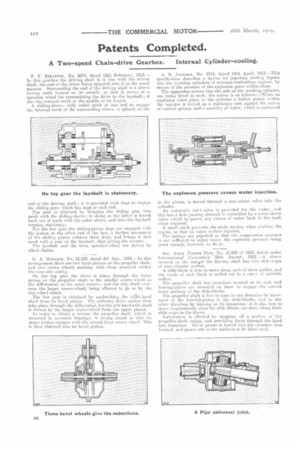Patents Completed.
Page 28

If you've noticed an error in this article please click here to report it so we can fix it.
A Two-speed Chain-drive Gearbox. Internal Cylinder-cooling.
F. F. STRATTON, No. 3674, dated 12th February, 1913.— In this gearbox the driving shaft is in line with the driven shaft, the end of the latter being spigoted into it in the usual manner. Surrounding the end of the driving shaft is a sleeve haying teeth formed on its outside, so that it serves as a sprocket wheel for transmitting the drive to the layshaft ; it also has internal teeth in the middle of its length.
A sliding-sleeve, with radial teeth at one end to engage the internal teeth of the surrounding sleeve, is spfined on the end of the driving shaft ; it is provided with dogs to engage the sliding gear, which has dogs at each end.
Top gear is obtained by bringing the sliding gear into mesh with the sliding-sleeve; in doing so the latter is forced back out of mesh with the outer sleeve, and thus the layshaft remains stationary.
For the low gear the sliding-pinion dogs are engaged with the pinion at the other end of the box, a further movement of the sliding pinion releases these dogs, and brings it into mesh with a gear on the layshaft, thus giving the reverse. The layshaft and the loose sprocket-wheel are driven by silent chains.
G. A. Mouriert, No. 15,522, dated 5th July, 1913.—In this arrangement there are two used pinions on the propeller shaft, and two crown wheels meshing with them mounted within the rear-axle easing.
On the top gear the drive is taken through the lower pinion on the propeller shaft to the smaller crown-wheel on the differential, in the usual mauner, and the axle shaft overruns the larger crown-wheel, being alloaved to do so by the free-wheel clutch.
The low gear is obtained by unclutching the right-hand shaft from its bevel pinion. The ordinary drive cannot then take plat* through the differential, but-the left-hand axle-shaft is driven by the larger crown-wheel from the upper pinion. in order to obtain a reverse the propeller shaft, which is mounted in eccentric bearings, is swung round AO that its upper pinion engages with the second large crown wheel. This is then clutched into its bevel pinion. A. H. JACESON, No. 8714, dated 14th April, 1913.—This specification describes a device for injecting cooling liquids into the working cylinders of internal-combustion engines, by means of the pressure of the explosion gases within them. The apparatus screws into the side of the working cylinder, one being fitted to each ; the action is as follows:—When an explosion takes place in the cylinder a hollow piston within the injector is forced up a stationary ram against the action of control springs, and a quantity of water, which is contained in the piston, is forced through a non-return valve into the cylinder.
An automatic inlet-valve is provided for the water, and this has a hole passing through it controlled by a screw-down valve which by-passes any excess of water back to the tank when required. A small catch prevents the parts moving when starting the engine, so that no water is then injected. The springs are adjusted so that the compression pressure is not sufficient to inject water, the explosion pressure being great enough, however, to do so.
Soc. ANONUSINE8 PIPE, No. 18,938 of 1913, dated under International Convention 24th August, 1912.--A sleeve secured on the end of the driving shaft has two slide-ways of semi-circular section.
A slide-block is free to move along each of these guides, and the inside of each block is milled out to a aurv2 of suitable radius.
The prop-Ike shaft has trunnions secured on its end, and bearing-pieces are mounted on these to engage the curved inner surfaces of the slide-blocks.
The propeller shaft is free to turn in one direction by movement of the bearid-pieees in the slide-blocks, and in the other direction by turning on its trunninns; it is also free to move longitudinally since the slide-blocks can move along their slide.ways in the sleeve. Lubrication is effected by stopping off a portion of the propeller-shaft, casing, and providing duets through the Invci and trunnions. Oil or grease is forced into the chamber thus formed, and passes out to the surfaces to be lubricated.




























